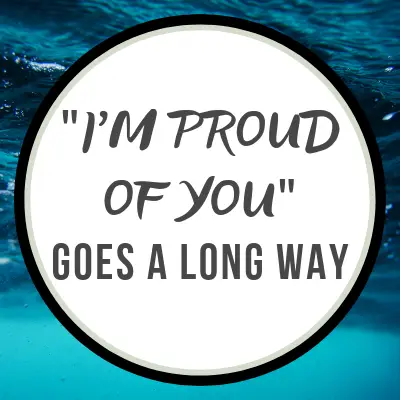New to swimming and still trying to figure out all the swim talk around the pool? You’re not alone! Swimming has hundreds of words unique to the sport that swim parents should know.
Related article: Swim Practice Terminology
Some are more important than others. And others, while important, aren’t heard as much.
Words and phrases vary not just by the team, but also by country. Learning the various words and expressions can be a delight. Because even though the word might vary, it’s meaning remains the same. More connects us than separates us 🙂
To help better understand your swimmer, here are 9 easy words that swim parents should know.
Disclosure: This post may contain affiliate links, meaning we earn a small commission at no cost to you if you purchase something through one of our links. As an Amazon Associate, we earn from qualifying purchases. Please check out our disclosure page for more information.

Dryland
Although swimmers and coaches probably don’t think much about it, ‘dryland’ is a funny word. Most swimmers will toss the word ‘dryland’ around and not think anything of it. But most other people have no idea what it means.
Dryland is simply cardio, core, and strength training done outside of the pool. We’re not sure who came up with the word or who coined it, but swimmers have embraced it.
If you’re new to the sport, expect to hear your swimmer or their coach mentioning dryland occasionally.
Related articles:
- How to Do Dryland Workouts at Home
- Best Dryland Equipment for Swimmers at Home
- Dryland Workouts without Weights at Home
Get Out Swim
If your swimmer finishes practice early, there’s a chance it’s due to a ‘get out swim.’ Get out swims happen when the coach offers the opportunity to finish practice early. On one or two conditions of course 😉
Usually, it’s a challenge, such as making a set at a certain time.
A get out swim can allow for an entire team to finish practice early. Or, only those who made the challenge. It all depends on the coach and what mood they’re in.
Some might not be a challenge at all. It could be something as simple as allowing swimmers to leave early if they have a water bottle.
Regardless of the opportunity, most swimmers enjoy get out swims. It’s usually a chance to swim fast and help your team along the way. The bragging rights aren’t that bad either :).
Drag Suit
In swimming, you try to avoid any type of drag as much as possible. It slows the swimmer down and makes it harder to move through the water. At least in competition.
At practice, it’s a bit of a different story!
A drag suit is a second swimsuit that’s worn over the first one. It’s usually much baggier or looser than a regular training suit. Some swimmers will take old suits that no longer fit tight enough and use them as a drag suit.
Swim brands, such as Speedo, Arena, FINIS, and others also sell dedicated drag suits. These drag suits typically come with an outer layer of mesh, designed to purposely catch the water.
Drag suits seem to go against conventional thinking when it comes to swimming. But they do serve a point!
Related articles: (coming soon!)
- What is a Drag Suit? (Drag Suit 101)
- Should I Wear a Drag Suit?
These suits make it more difficult to move through the water, thus making the swimmer work harder. But when the swimmer removes the drag suit, they feel as though they’re practically flying through the water as they’re no longer fighting the drag.
It’s a small change, but it makes a huge difference. Especially if you’re wearing a larger drag suit.
As a swim parent, talk with your swimmer’s coach to see if your child should use a drag suit. Males and females alike can wear them. And while they offer some great benefits, they also bring about some challenges and negative effects, too.
Chutes and Bungees
Chutes and ladders anyone?
If your child ever comes home saying they had the chance to use a parachute or bungee, don’t freak out! They didn’t go parachuting or bungee jumping 😉
Swim parachutes (aka chutes) and swim bungees are training tools used to help with swim resistance. Much like drag suits create drag and resistance, so too do swim chutes and bungees.
A swim parachute, or chute, is probably exactly as you’re imagining. It’s a parachute attached to a swimmer. Just on a much, much smaller scale. The chute attaches to the swimmer via a belt and it drags behind them as they swim.
Chutes come in different sizes for levels of resistance. The larger the size the more drag and resistance.
Swim bungees operate much like a swim parachute.
They connect to a swimmer’s waist and are anchored to a stationary point. Typically the backstroke bar of a starting block. From there, the swimmer swims out against the cord for a determined amount before coming back.
Related article: A Swimmer’s Review of the YYST Swim Bungee
Bungees come in different resistances based on the band/cord that’s used. Some can easily stretch to the other end of the pool. While others will only make it to the flags. This allows for an array of different training techniques.
Taper (or Tapering)
Almost every swimmer looks forward to the word ‘taper’ coming from their coach. It’s that amazing time of the season where practices become easier and shorter. Some, but not all, swimmers feel better and more rested.
Taper typically happens at the end of each season, or just before large championship meets. During this time, the distance a swimmer usually puts in decreases, as does the intensity of the sets.
It allows the muscles and body to repair, encouraging the swimmer to feel more rested. Thus, going faster at a meet. A well-rested body typically performs faster and better than a broken down and tired one.
Every swimmer tapers differently though. Some will continue to train longer than others, while others might begin their taper earlier.
Shaving Down
One weird quirk of swimmers is shaving down. And most new swim parents are honestly baffled by it. If you’ve never heard of shaving down, that’s okay! It’s not something most coaches talk about when you’re joining a team.
In swimming, reducing drag at a meet is important. Though minor, body hair can result in drag while competing. Can you see where this is going? 😉
Related article: Parents Guide to Swim Meets
Part of the swimming culture is that swimmers don’t shave throughout the year until much larger meets. They let their leg hairs keep growing until they can finally shave them off. Usually for a championship level meet.
Hence, shaving down!
This goes for males and females. And yes, the guys hate shaving and the girls hate letting their leg hair get that long.
Shaving down is the final piece of taper and is done the day or so before the meet. Some teams will get together and have a ‘shaving party’. Where everyone gathers around a tub or some container of water and shaves off their leg/arm hair.
It can get pretty gross with all that shaving cream and hair floating through the water. But once done, females happily show off their new shaved legs. And the guys will bemoan their shaved legs.
Pasta Party
It’s a bit of an odd phrase (much like most of what’s on this list), but swim parents will hear this frequently. Especially if your child is a high school swimmer.
Teams will get together before large meets to help with team morale. But also to stock up on plenty of carbs just before a meet. Typically, every swimmer will bring a dish, usually pasta, for the team to share.
And then everyone overloads on carbs!
We’ll be honest and admit that we typically don’t go to these. Mainly in part because eating something that someone else made increases the risk of an upset stomach. And increases the chance of getting sick.
If you have a picky eater or someone with a sensitive stomach, there are still ways that they can participate. Have them bring their own pasta to eat so they can still be included but can avoid the bathroom drama later.
Happy swimmers all around!
Winter/Holiday Training
Every year, school lets out for winter break and most kids look forward to the time away from the school. Except for swimmers, haha.
With school done for the year, swimmers (in the coach’s mind) have nothing else to do but focus on swimming. Winter training truly turns into ‘eat, sleep, swim, repeat’ during these weeks.
You’ll typically see an increase in hours spent at the pool and the distance trained each day. And some teams might switch from short course to long course training during this time.
While this typically holds true for high school and above swimmers, some younger swimmers might still see an increase in their training too.
If your child is joining a team, high school, club, college, or otherwise, be sure to ask about holiday training. Especially if you plan to go on a vacation during that time.
Colleges especially require that their swimmers come back to campus for training. Some will take travel trips for their winter training and others will stay on campus.
I’m Proud of You
Whether at practice or a meet, swim parents should always know the words ‘I’m proud of you’.
Swimming is a challenging sport. Where your child will swim for hours every day at the pool and focus on their health and nutrition away from the pool. It’s much like a job and the rewards aren’t easy. And they don’t come quickly.
That said, it’s easy for swimmers to get discouraged. Especially if they’re not dropping time as they wanted. Or if they hit a plateau.

Berating your child for not winning or dropping time isn’t going to make them swim faster or harder. It’ll only make them resent the sport. And possibly you.
Instead, let them know that no matter what, you’re still proud of them. And that you know they tried their best. Everyone has bad swims, bad meets, and even bad seasons. Don’t make it seem as though it’s the end of the world. It’s really not.
Related articles:
Practice patience with yourself and learn to check yourself when you become overbearing. Have an accountability partner to make sure you’re not being over-controlling
And remember. It’s just four simple words. I’m proud of you.
Out of all 9 words that swim parents should know, this is the most important and one you should get into the habit of saying the most.
As always, to happy swimming!
Chevron
Bonus Content:
8 Things Every Swim Parent Should Know: There’s a fine line between being supportive and overbearing. As a swim parent, you need to learn how to find that balance.
What to Know Before Your Child Joins a Swim Team: When your child joins a swim team, they rely on you to help them succeed. And not considering these 4 things can cause surprises along the way.

Want to Improve at the Pool?
Join swimmers and swim parents to receive my free newsletter and receive a free Swimming Glossary e-book as a thanks!
Every month you’ll receive tips and coaching to help you find success at the pool.
About
Chevron is a current competitive swimmer with almost 20 years of experience in the pool. And although she fell into the sport by accident in her high school years, she still trains daily and competes throughout the year. She’s committed to providing guidance to all levels of swimmers and believes that everyone should know how to swim.